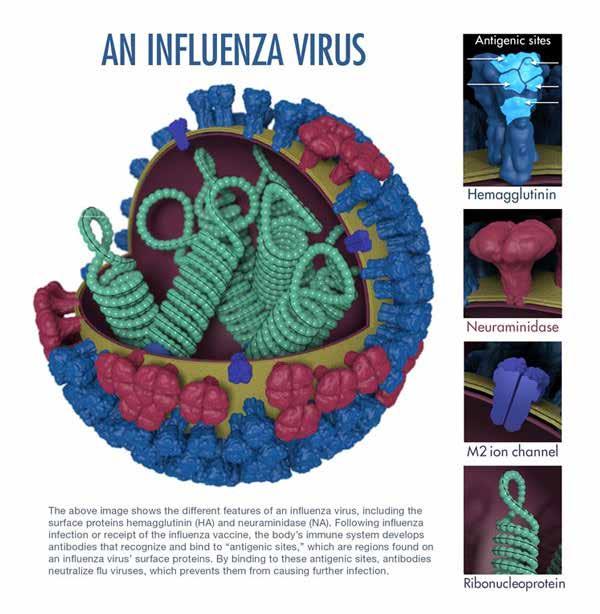INFECTIOUS DISEASES
Susceptibility Breakpoints for Common Antibiotics Used in Adult Horses DRUG
SUSCEPTIBILITY BREAKPOINT
ADMINISTRATION
Chloramphenicol
≤1 µg/mL
50 mg/kg PO every 6-8 h
Enrofloxacin
≤0.25 µg/mL
7.5 mg/kg once daily1
Trimethoprim-Sulfa
≤0.5 µg/mL for trimethoprim/9.5 µg/mL for sulfonamide
30 mg/kg PO every12 h2
Minocycline
≤0.25 µg/mL
4 mg/kg PO, every 12 h
Doxycycline
≤0.25 µg/mL
10 mg/kg PO every 12 h
1. In some cases: ≤0.5 µg/mL could be targeted after administration of enrofloxacin tablets either orally or intragastrically. 2. Except for Equisul SDT, which would be 24 mg/kg PO, every 12 hours Magdesian G. AAEP Proceedings 2019, Vol. 65
Susceptible, Intermediate, Resistant: What Does That Mean? A SUSCEPTIBLE (S) ORGANISM, usually designated by S, means the antimicrobial concentrations needed to inhibit the organism are readily achieved in serum after recommended equine dosing, i.e., the antibiotic is appropriate. INTERMEDIATE (I) MEANS the antimicrobial concentrations needed to inhibit the organism may or may not be achievable in serum after recommended equine dosing, i.e, there is a chance the therapy might not work. RESISTANT (R) MEANS the antimicrobial concentrations required to inhibit the organism is higher than the achievable serum concentrates after recommended dosing, i.e, the antibiotic is inappropriate for this infection. Magdesian G. AAEP Proceedings 2019, Vol. 65
Some laboratories don’t report the MIC, but instead report whether an isolate is “susceptible,” “resistant” or “intermediate” to the tested antimicrobials. Laboratories report susceptibility breakpoints set by the Clinical and Laboratory Standards Institute. The susceptibility breakpoint is the lowest concentration of an antibiotic that inhibits bacterial growth and can be achieved in the patient after conventional dosing, Dr. Magdesian explained. These values are based on the pharmacokinetics of the individual drug, the target species and the MIC of the bacterial isolate. Feline veterinarians are always saying that cats are not small dogs when it comes to medications. The same idea can be applied to medications for horses: horses are not humans—they often have decreased bioavailability of oral medications, so the achievable serum and concentra-
tion of these drugs are different for horses than humans. This is important to keep in mind because CLSI provides veterinary susceptibility breakpoints for just a few antimicrobials for horse, so some of the results on that report from the diagnostic lab on your desk or phone might be based on the susceptibility breakpoint for human patients. This is less of an issue for IV or most intramuscularly administered equine drugs, “because the cutoff values used for susceptibility in terms of MICs would be the same or similar among horses, small animals and humans. “For example, if we're talking about IV penicillin or IV cephazolin, then the human breakpoints would apply,” he said. Because of a horse’s decreased bioavailability for many orally administered medications, the human values won’t necessarily apply, according to Dr. Magdesian. “If the diagnostic lab is using human values, the microbe could appear susceptible when in reality, the horse can't achieve those same concentrations.” A good example is cloramphenicol. For humans, the CLSI guideline is 8 µg/mL as a susceptibility break point for most bacteria, which means if the isolate has an MIC of 8 µg/mL or below, it would be considered susceptible. If the MIC is above 16, it would be considered resistant. “That's for humans. Now, can horses achieve 8 µg/mL of chloramphenicol in their plasma after oral administration? No, most horses don’t achieve such levels because of reduced bioavailability,” Dr. Magdesian said. For horses, a susceptible isolate would have an MIC of 1 or 2 µg/mL or less for chloramphenicol, because that is the plasma level that can be reached in most horses using recommended oral dosing. “If the microbe is inhibited at that concentation, then it would be considered susceptible for horses. If the microbe isn’t inhibited by that achievable concentration, then it should be considered resistant in horses,” Dr. Magdesian said. “The thing to keep in mind here is that the lab you’re using may be using human standards when they are not available for horses,” he said. “It will tell you an isolate is susceptible when in reality it isn't [for your equine patient],” he said. When in doubt call the laboratory and ask for the actual MIC, rather than just the susceptibility (S) or resistant (R) designation, especially for orally administered antimicrobials. MeV
For more information: Silley P. Susceptibility testing methods, resistance and breakpoints: What do these terms really mean? Rev Sci Tech. 2012;31:33-41. https://www.oie.int/doc/ged/D11778.PDF 6
Issue 2/2020 | ModernEquineVet.com



